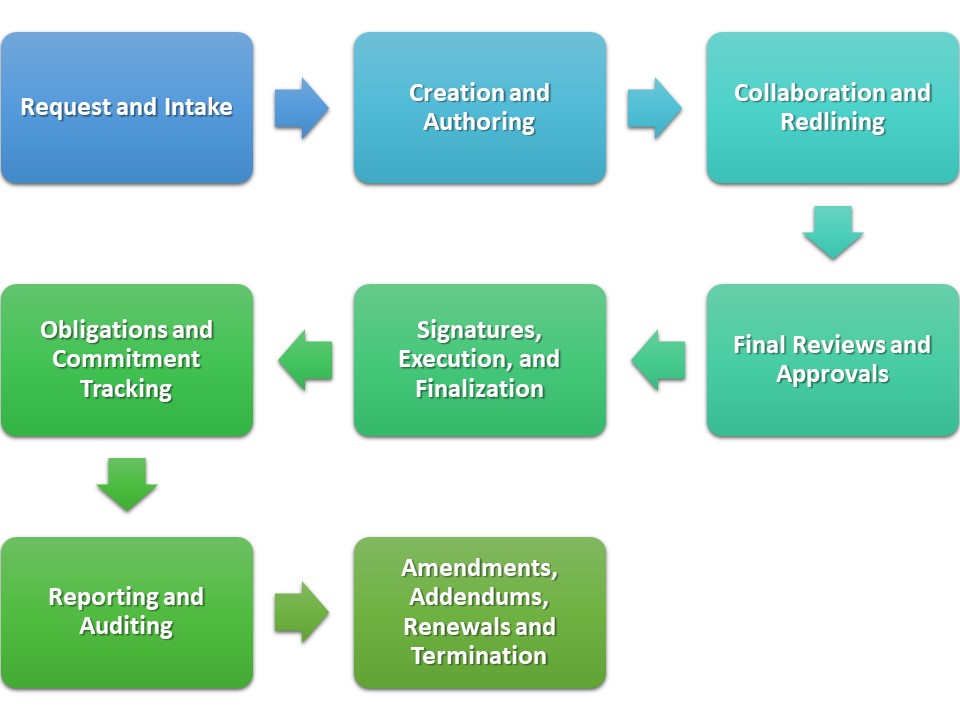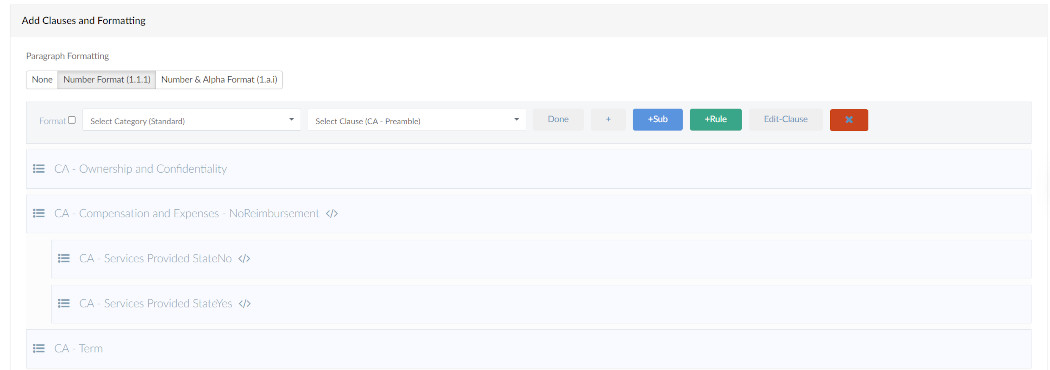What is Contract Workflow?
Contract workflow entails the entire process of creating and executing a legal contract. Every organization’s contract workflow is unique, but all workflow falls into the same general pattern, as you’ll learn in this article.
Key Takeaways
- Contract workflow involves every step in the process of creating, executing, and managing contracts.
- Contract workflows are used to follow the eight general steps of a contract’s lifecycle, starting with request and intake and ending with renewing or terminating expiring contracts.
- Contract workflow can be made more efficient with the use of contract lifecycle management (CLM) software.
- CLM software provides numerous benefits, including streamlining and automating the workflow, improving compliance, increasing speed, reducing errors, and reducing costs.
Contract Workflow Defined
Contract workflow is every activity an organization takes to create and legally execute a contract. Workflows can be defined for every step of the process, from inception and authoring through negotiation and approvals to execution and renewal or termination. Workflows are a key component of business process management and are designed to follow business rules to ensure compliance with an organization’s approved contracting processes.
Contract workflow is often referred to as the contract lifecycle and can be automated by the use of contract management software, such as that offered by Contract Logix.
Understanding the Steps of the Contract Workflow
While the details vary from organization to organization, a contract workflow or workflows are used to facilitate the typical eight stages of a contract’s lifecycle. Contract workflow can be completely manual, completely automated, or some combination of the two approaches.

1. Request and Intake
The workflow starts when the contract is initiated and key information is provided. As to who can request contracts, that differs from organization to organization. Most companies only let certain employees or employees above a certain level initiate contracts. In this stage, a contract request is initiatives which can kick-off a workflow for that request to be approved and a contract to be created. Depending on the contract type, value, or complexity, the request can be routed by a workflow to the appropriate person or department for approval.
2. Creation and Authoring
Once the request is approved, a first draft of the contract is prepared based on the information provided. In some cases, a workflow can autogenerate a contract such as a NDA. Again, who drafts or assembles the contract is specific to your organization and the contract type and complexity. Some companies require that the requesting employee draft the contract; others have staff familiar with contracts do the drafting such as someone from the in-hosue legal team.
3. Collaboration and Redlining
Now that first draft of a contract is created, it’s needs to be circulated internally and with the third party. A workflow can kick off this process using real-time collaboration tools such as Contract Logix’s Collaboration Room and notify the appropriate people. Any requested changes must be negotiated and edited into the contract. Who you circulate contracts to is specific to your organization and the third party.
4. Final Reviews and Approvals
AFter all parties agree on changes, the edited contract is recirculated to relevant stakeholders for a final review and approval. In most organizations, this final review includes legal staff. Workflows can be built to follow business rules based on certain review and approval criteria. For example, perhaps a contract over a certain dollar value needs to include the CFO in the review and approval. A workflow can facililate all of this based on your specific business process.
5. Signatures, Execution, and Finalization
Once everyone necessary reviewed and approved the contract, the contract is put out for signatures from officials of both parties. Signing can either be in-person or via e-signature. Using e-sign technologies that are integrated into your contract management software, a workflow can send the agreement out for signature once the agreement is ready. The executed contract is automatically married back up into the software and again, relevant parties are notified via a workflow process.
6. Obligations and Commitments Tracking
Everything you’ve committed to in the contract must be tracked so that you meet those obligations. It’s also important to track deliverables from the other party. Workflows can be created to trigger alerts and notifications on key dates, milestones and other commitments. This ensures the right parties are informed of upcoming requirements such as the need to review and pending autorenewal or a commitment to send a client a deliverable in a certain timeframe.
7. Reporting and Auditing
Contractual information should be fed into your organization’s reporting system so key data can be extracted when requested. Contract storage should facilitate easy access in the event of an audit. Using workflows, reports can be generated by your contract management software on a one-time or on a regular basis and distributed to the appropriate personnel.
8. Amendments, Addendums, Renewals, and Termination
The final step in your contract workflow concerns the disposition of the contract at the end of its lifecycle. Favorable contracts that can be renewed should be renewed, others might be renegotiated, and some may be allowed to expire. Again, workflows can facilitate this process according to your business rules.
Important Benefits of Automating Contract Workflow
Traditionally, managing an organization’s contract workflow was a manual process, complete with physically walking around paper contracts for editing and approval. Or, it may have involved endless emails and voicemails that get lost in teh shuffle and ultimately, slow down the process which increases cost and introduces risk.
Today, contract workflow can be automated by the use of contract lifecycle management (CLM) software, which offers multiple benefits.
Streamlined Workflow
Perhaps the most noticeable benefit of automating contract workflow with CLM software is that the entire workflow is streamlined. Automating contract creation, execution, and other key steps makes everything more efficient, speeding up the entire process which reduces risk and helps finalize business faster.
Faster and Easier Contract Creation
With CLM software, you no longer have to create every contract from scratch. Most CLM solutions, including those from Contract Logix, include a variety of contract templates that include preapproved language and elements, including
- Terms
- Conditions
- Clauses
An automated workflow can be created to convert a contract request into an actual contract using merge fields and approved clauses and templates. This makes creating negotiation-ready contracts fast and easy, saving your staff much time and effort.

Improved Internal and External Compliance
In Contract Logix, contract workflows are built to automatically follow your business rules. This ensures that contracts adhere to processes and guidelines for things like reviews, approvals, signatures, and more. Automated workflows play a huge role in improving compliance by eliminating the mistakes caused by manual and human errors such as sending the contract to the wrong person for approval.
Fewer Errors
Assembling new contracts with workflows that leverage preapproved clauses and template libraries also reduces the incidence of errors, resulting in more accurate contracts. In addition, centralizing contract requests using standard forms that gather all the information up front while using a workflow to then approve that request before it comes a contract also reduces errors. That means less time fixing mistakes – and less legal risk from inaccurate language.
More Accurate Tracking
With manual contract workflow, physical contracts can get misplaced or lost in the process, costing you time and often deals. CLM software from Contract Logix automatically tracks the progress of each contract so that you always know where each contract is in the process. Nothing gets lost and everything moves from point to point with the utmost efficiency and speed. This also frees up your legal resources to focus on more strategic activities and less on routine tasks.
Improved Obligation Fulfillment
CLM software lets you set automatic notifications for all upcoming contractual deadlines – both yours and the other parties’. No deliverables will ever again slip between the cracks. You will never have to remember to configure email calendar reminders or other reminder types. The automated workflows in CLM software can create rules-based notifications and alerts for any type of reminder such as the need to send a client deliverable or review a price volume discount milestone.
Improved Renewal Handling
In a manual system, older contracts sometimes get forgotten and are allowed to expire without any action being taken. CLM software notifies you when renewal and expiration dates are approaching so you can determine the proper disposition of each contract.
Reduced Contract Value Leakage
Contract value leakage is the difference between the expected value of a contract and the actual value realized over the life of the contract – which can be significant. The World Commerce and Contracting group says that the average contract loses 12.4% of its expected value due to value leakage. By better managing all aspects of the contract workflow, CLM software helps you retain more value for each contract you execute.
Let Contract Logix Help You Automate Your Contract Workflow
CLM software from Contract Logix can help you better manage your entire contract workflow. Our CLM Platform automates the entire contract management process from initiation and intake to execution and disposition.
We’ve helped hundreds of companies enhance their traditional contract workflow with powerful CLM solutions. We’ll show you how to make CLM work for your organization – and make your contract workflow faster, more efficient, and more effective.
Contact Contract Logix today to learn more about automating your organization’s contract workflow.


